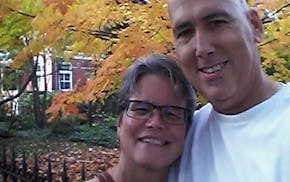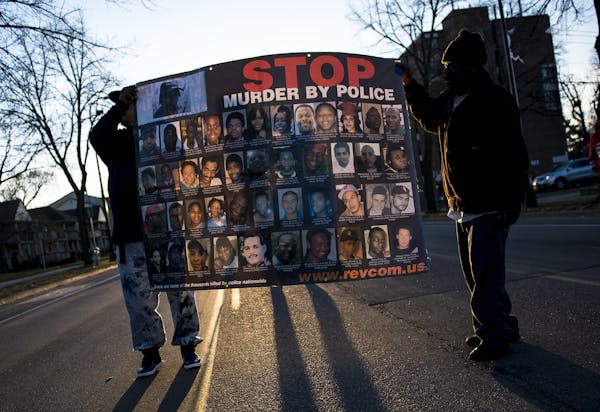There is a reason archaeologists study graves to identify a culture's social structure and inequities. Where and how our bodies go when we die often tells us about how we lived. Bones don't lie.
Jamar Clark's grave is in Minneapolis, just a few miles from where he was shot and killed after a 61-second encounter with Minneapolis police. It is marked by a rectangle of dirt, tamped down and waiting for a spring seeding. There is still no stone or marker, so a groundskeeper had to bring me to the site using a map. Lot 25. Section 155. Grave 5.
"Jamar Clark?" he asked.
A few hours after Hennepin County Attorney Mike Freeman announced that he would not charge the two police officers involved in the altercation, Clark's grave gave no indication of a young man whose death exposed yet again the deep divide in the city.
There were no flowers, no footprints in the wet grass.
Yet downtown, hundreds of demonstrators chanted his name in unison.
Jamar!
Clark!
Jamar!
Clark!
It was the culmination of a remarkably sad day in Minneapolis. In explaining his decision, Freeman released an unprecedented amount of data which, despite its volume, failed to answer the question that really nags at our nation: Why do so many young black men get killed by police?
The data itself is sobering, an unvarnished glimpse into the acrimonious relationship between police and segments of the black community. Wade through the police incident reports and watch the videos and you quickly detect in the descriptions and interviews a stunning mutual lack of respect.
Cops condescend to witnesses and bystanders, who in turn refuse to cooperate — or call them names and threaten them. The data is indeed revealing. But data doesn't take us into the mind of a young man who won't follow a command for a few seconds to take his hands out of his pockets. Data doesn't take us into the mind of a cop who determines a few seconds is long enough before a violent takedown is necessary.
Data doesn't account for the decades of experiences inside Clark and the officers that made this moment almost inevitable.
One released video completely unrelated to the incident, but intrinsically related to Clark's relationship with police, is his interview after his arrest for fleeing police in a stolen car.
Clark is calm but uncooperative. He refuses to give the officer his birth date or address.
"Continue to be this way, judges love it," says the officer.
Given his right to a phone call, Clark hesitantly calls his mother to explain he is in jail. He had been punched by an officer, he says, and went into a seizure. He ends the call: "I love you too, mom."
After the call, Clark's demeanor changes and the relationship becomes almost familial. The officer tells Clark to put his shoes back on because he has "smelly feet."
"Foot powder will help," says the officer. "I'm not trying to pick on you. My kids have the same problem."
The documents are filled with similar interactions, moments when the acrimony subsides and the humanity of the cops and community comes through, and all of it happens when they have been together more than 61 seconds.
Freeman's refusal to charge the officers was predictable. The way the law is written, it is nearly impossible to convict police of murder unless there is proof beyond a reasonable doubt that the use of force is not justified. That rarely happens. Taking a weak case to a jury would not have changed anything, nor anyone's feelings.
But the inability to prove a criminal act does not exonerate officers from bad police work. The blurry videos available cannot capture Clark's demeanor or facial expression, but none of them shows him to be acting wildly or unpredictably. Officer Mark Ringgenberg used a takedown move on Clark that Freeman acknowledged was "not favored" by Minneapolis police.
Maybe we should change "not favored" to "banned."
Almost every controversial incident between cops and black men begins with some similar scenario, from Eric Garner's death in New York to the tasering of Chris Lollie in St. Paul: A man momentarily hesitates to comply with an order, an officer quickly gets physical and a bad outcome becomes inevitable. Better and more frequent training in de-escalation techniques is imperative.
It needs to be said that none of these questions would be in play if not for the persistence of groups such as the NAACP, Black Lives Matter and the Twin Cities Coalition For Justice 4 Jamar. While I sometimes disagreed with their strategies or rhetoric, they were forceful and nonviolent in their pursuit of answers.
On Wednesday evening, the demonstration swelled as it moved from Elliot Park to the city's center. People watched from skyways and office buildings as a racially diverse crowd sang and chanted, determined not to let us forget the unnecessary death of a young man buried in an unmarked grave a few miles away, where by Saturday, someone had scrawled "I want justice" in the dirt.
jtevlin@startribune.com • 612-673-1702

Tevlin: 'Against all odds, I survived a career in journalism'

Tevlin: Grateful Frogtown couple fight their way back from fire and illness




